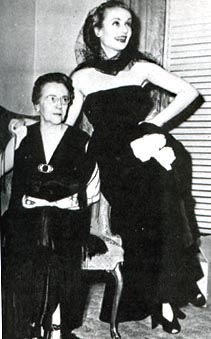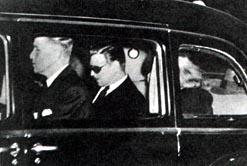 Carole
Lombard's flight left Indianapolis at four A.M., Friday, January
6 [1942]. Flying time to Los Angeles was seventeen hours;
with time changes the expected arrival at the Burbank airport
was six P.M. on Friday. Most of the passengers were members
of the Army Ferrying Command. When they made a scheduled Stop
in Albuquerque, they found nine officers waiting with military
orders enabling them to bump any civilian or Ferrying Command
pilots off the plane. But Lombard argued that having just
sold two million dollars' worth of war bonds, she must have
some "rank." She could be very charming and amusing in this
kind of situation, as anyone knows who has seen her on the
screen. The Army officials gave in, permitting Lombard, her
mother, and Winkler to continue on the flight. Winkler wired
MGM that they would be an hour late arriving at Burbank, and
the studio made arrangements to have Larry Barbier, an MGM
public relations man, meet the plane.
Carole
Lombard's flight left Indianapolis at four A.M., Friday, January
6 [1942]. Flying time to Los Angeles was seventeen hours;
with time changes the expected arrival at the Burbank airport
was six P.M. on Friday. Most of the passengers were members
of the Army Ferrying Command. When they made a scheduled Stop
in Albuquerque, they found nine officers waiting with military
orders enabling them to bump any civilian or Ferrying Command
pilots off the plane. But Lombard argued that having just
sold two million dollars' worth of war bonds, she must have
some "rank." She could be very charming and amusing in this
kind of situation, as anyone knows who has seen her on the
screen. The Army officials gave in, permitting Lombard, her
mother, and Winkler to continue on the flight. Winkler wired
MGM that they would be an hour late arriving at Burbank, and
the studio made arrangements to have Larry Barbier, an MGM
public relations man, meet the plane.
The
plane made an unscheduled stop in Las Vegas and at 6:50 P.M.
proceeded west. The pilot, Wayne Williams, seemed unconcerned
when he reported at 7:07 P.M. that he was slightly off course,
about thirty-five miles west of Las Vegas. Eyewitnesses later
reported that it was just about that time that the plane burst
into flames. Some thought it happened just before the plane hit Olcott Mountain (also called Table Rock
and Double U Peak); there was speculation that the absence
of beacons -- blacked out for fear of Japanese air raids--was
responsible for Williams's losing course. (Later investigations
revealed that the pilot, who had been reprimanded several
times for not following flight instructions, was taking a
shortcut through a restricted area to make up for lost time.)
before the plane hit Olcott Mountain (also called Table Rock
and Double U Peak); there was speculation that the absence
of beacons -- blacked out for fear of Japanese air raids--was
responsible for Williams's losing course. (Later investigations
revealed that the pilot, who had been reprimanded several
times for not following flight instructions, was taking a
shortcut through a restricted area to make up for lost time.)
Barbier,
waiting at Burbank, was the first to hear that there had been
a plane crash. He immediately called Howard Strickling, another
MGM publicity man and close friend of Gable's. Strickling
told Barbier to charter a plane; then he called Gable, who
immediately left for the airport with MGM executive Ralph
Wheelright. Jill Winkler, Lombard's brothers Stuart and Fred
Peters, and Fred's wife left for Las Vegas by car. MGM executive
Eddie Mannix took a scheduled flight.
 On
the chartered flight to Vegas, Strickling would recall, Gable
was tense "because he sensed what had happened... You knew
you shouldn't talk to him. You knew not to say, "It's going
to be all right," or "I'm sorry." When Gable and his group
finally reached the base of the mountain, he wanted to go
with the second search group, which included stretcher-bearers
and medical supplies, but was persuaded to stay behind. Mannix
and Wheelright went, however; years later, Mannix said Lombard
was burned and headless and that Gable had been told.
On
the chartered flight to Vegas, Strickling would recall, Gable
was tense "because he sensed what had happened... You knew
you shouldn't talk to him. You knew not to say, "It's going
to be all right," or "I'm sorry." When Gable and his group
finally reached the base of the mountain, he wanted to go
with the second search group, which included stretcher-bearers
and medical supplies, but was persuaded to stay behind. Mannix
and Wheelright went, however; years later, Mannix said Lombard
was burned and headless and that Gable had been told.
 Gable
rode on the train that carried the bodies back to Los Angeles
and then purchased three crypts at Forest Lawn cemetery, one
for Carole, one for her mother, and one for himself: The Army
offered to give Carole a military funeral, and the Hollywood
Victory Committee wanted to build a monument honoring the
first star to give her life for her country. But Gable refused
both suggestions, explicitly carrying out his wife's funeral
instruction:
Gable
rode on the train that carried the bodies back to Los Angeles
and then purchased three crypts at Forest Lawn cemetery, one
for Carole, one for her mother, and one for himself: The Army
offered to give Carole a military funeral, and the Hollywood
Victory Committee wanted to build a monument honoring the
first star to give her life for her country. But Gable refused
both suggestions, explicitly carrying out his wife's funeral
instruction:
I
request that no person other than my immediate family and
the persons who shall prepare my remains for interment be
permitted to view my remains after death has been pronounced.
I further request a private funeral and that I be clothed
in white and placed in a modestly priced crypt in Forest Lawn
Memorial Park, Glendale, California.
The
death of Carole Lombard was Hollywood's first wartime tragedy.
Those who were close to her, like Spencer Tracy, went into
deep depression; Lucille Ball said she never really lost touch
with her friend, that Carole visited her in her dreams for
years, often advising her on important decisions....